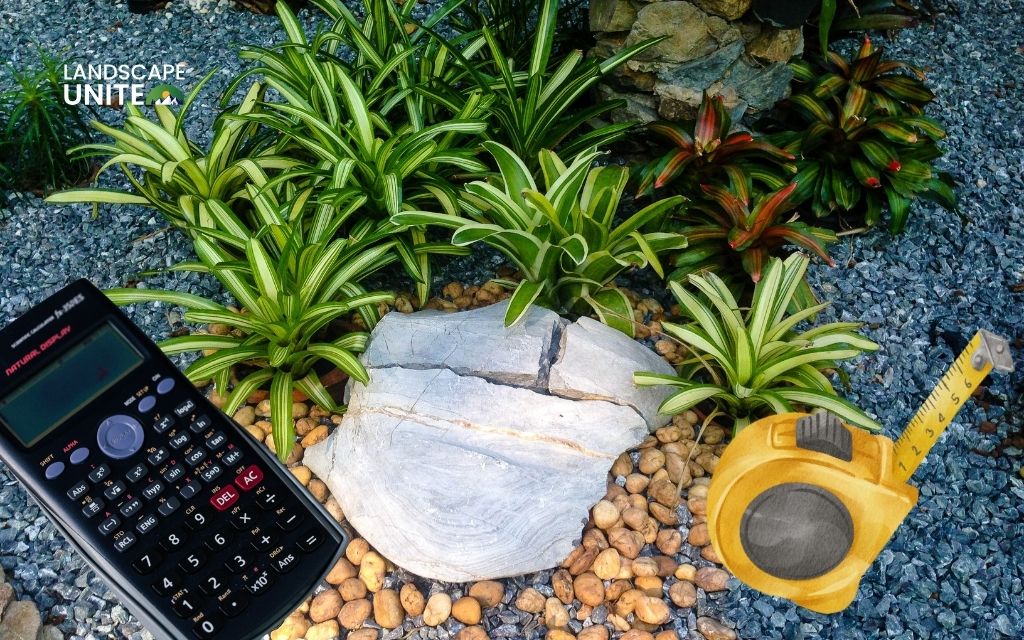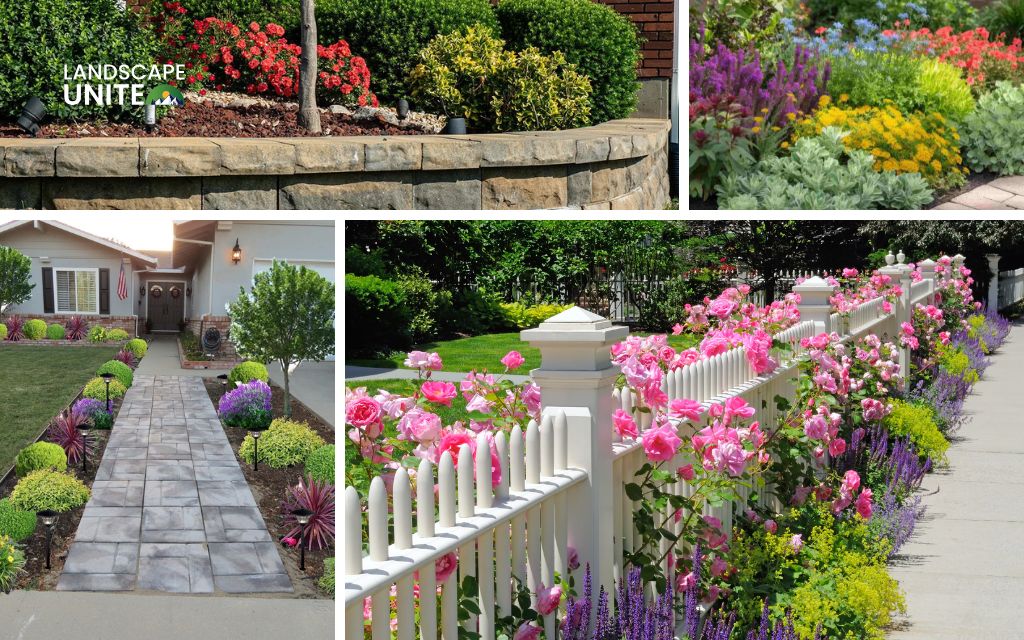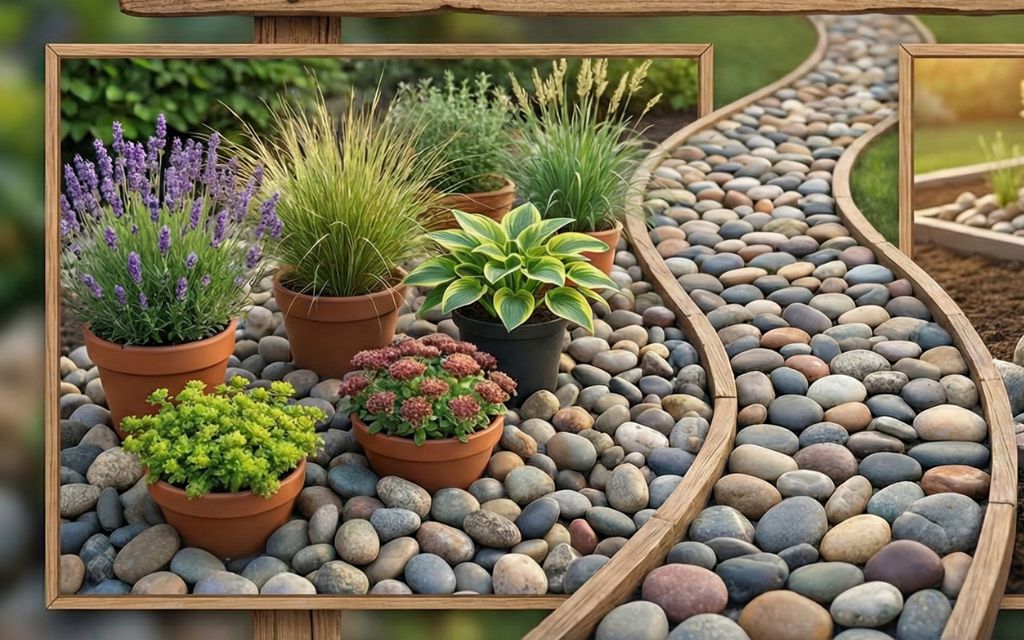While rabbits may be adorable, their voracious appetite can wreak havoc on flower beds, vegetable gardens, and young shrubs in surprisingly little time.
If you’re wondering how to keep rabbits out of your garden, you’re not alone – this is one of the most common challenges facing American gardeners. The good news? You don’t need methods that harm wildlife to protect your plants.
This comprehensive guide will show you how to get rid of rabbits in your yard using safe, humane, and budget-friendly approaches that actually work.
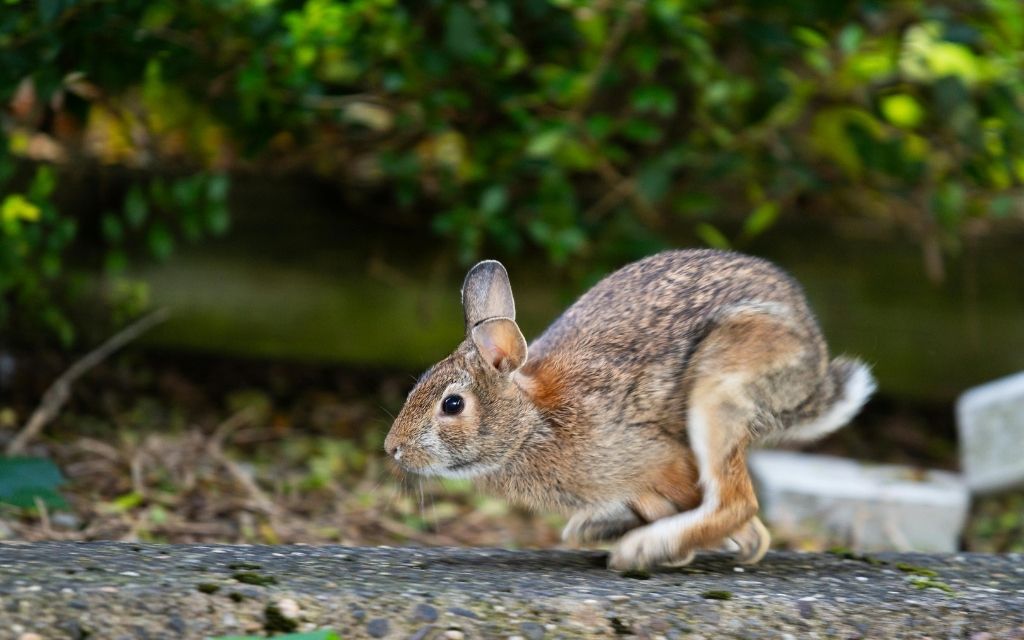
Signs rabbits are in your garden
Before you can effectively deter rabbits from garden spaces, you need to confirm they’re actually the culprit.
Rabbit damage has distinctive characteristics that set it apart from other garden pests:
- Clean-cut damage on leaves and stems: Unlike insect damage that appears ragged or torn, rabbits have sharp incisors that slice through plant material cleanly. You’ll notice stems look like they’ve been cut with scissors.
- Small, round droppings scattered near affected plants are another clear indicator. Rabbit pellets are roughly pea-sized, dry, and fibrous.
- Shallow burrows or tunnels near garden edges, under shrubs, or along fence lines suggest rabbits have established territory in your yard. These aren’t deep warrens but rather simple hiding spots.
- Plants disappearing overnight is perhaps the most frustrating sign. Rabbits are most active during dawn and dusk, which means you might wake up to find entire rows of seedlings completely vanished. Young vegetables and annual flowers are particularly vulnerable to this overnight devastation.
What attracts rabbits to your yard
- Tender new growth, vegetables, and annual flowers: Spring gardens filled with young lettuce, beans, peas, and soft-stemmed flowers act like an all-you-can-eat buffet. Rabbits particularly love succulent growth that’s easy to chew and digest.
- Ground-level food sources make feeding effortless for these low-to-the-ground creatures. Clover-filled lawns, ground covers, lettuce patches, and young shrubs require minimal effort to reach. Unlike deer that browse higher vegetation, rabbits focus on what’s within easy hopping distance.
- Overgrown lawns or brush piles offering hiding spots create the perfect rabbit habitat. These animals are prey species, so they seek yards that provide both food and protective cover. Tall grass, dense groundcover, untrimmed hedges, and accumulated yard debris all signal “safe haven” to passing rabbits looking for a place to settle.
11 Proven ways to keep rabbits out of your garden
Now let’s explore the most effective strategies to repel rabbits and protect your plantings.
The key to success is combining multiple methods – rabbits are persistent, so layering your defenses yields the best results.
1. Install fencing
When it comes to how to keep rabbits out of the garden permanently, fencing remains the gold standard. Physical barriers provide reliable, long-term protection that doesn’t require constant reapplication.
Choose hardware cloth or chicken wire with 1-inch mesh or smaller – this prevents even young rabbits from squeezing through.
Bury the bottom 6–12 inches underground and bend it outward at a 90-degree angle. This L-shaped footer prevents rabbits from digging under, which is their instinctive response when encountering barriers. This step is absolutely critical – skip it, and you’ll find tunnels beneath your fence within days.
Your fence should stand at least 2 – 3 feet high above ground. For vegetable gardens, you can create affordable enclosures using metal stakes and rolled wire fencing.
2. Use natural rabbit repellents
For those seeking how to repel rabbits without permanent structures, natural rabbit deterrent sprays offer a flexible, eco-friendly option. These work by making plants taste or smell unpleasant without harming rabbits or your garden ecosystem.
- A simple DIY mix combines 1 tablespoon hot sauce, 1 tablespoon dish soap, and 1 gallon of water. The capsaicin from hot peppers creates a burning sensation rabbits quickly learn to avoid, while dish soap helps the mixture adhere to leaves.
- Other effective homemade options include garlic spray (blend several cloves with water and strain) or vinegar solution (equal parts white vinegar and water).
- Reapply after rain or watering, as these natural solutions wash away easily.
For convenience, commercial eco-friendly repellents like Liquid Fence, Bonide Repels-All, or I Must Garden offer ready-to-use formulas. These products typically combine multiple deterrent scents and often last longer between applications than homemade versions.
3. Grow rabbit-resistant plants
Rabbits avoid plants with strong scents, fuzzy textures, toxic compounds, or bitter tastes.
Examples of plants rabbits won’t touch include:
- Annuals and perennials: Sweet Alyssum, Lantana, Marigold, Geranium, Wax Begonia, Vinca, Snapdragon, Sunflower, Salvia, Milkweed, Catmint
- Shrubs and woody plants: Butterfly Bush, Clematis, Coral Berry, Deutzia, Juniper, Lilac, Rose of Sharon, Spirea
- Herbs with strong scents: lavender, rosemary, oregano, and sage
Plant these rabbit-resistant varieties around borders to create a protective barrier that shields more vulnerable plants behind them. This living fence approach is both beautiful and functional.
4. Protect young plants with covers or cages
Seedlings and new transplants are especially vulnerable to rabbit damage.
Use wire cloches, plastic mesh domes, or row covers to create physical barriers over individual plants or entire rows. This method is essential for vegetable gardens and new transplants, such as lettuce, beans, peas, and brassicas that rabbits find irresistible.
Even just a few weeks of protection gives plants time to establish stronger stems and develop less palatable mature foliage.
Remove covers during flowering to allow pollinators access to blooms. For vegetables that require pollination, this timing is crucial. Once plants reach maturity and develop tougher stems, they can often withstand occasional nibbling without significant damage.
5. Maintain a clean, open yard
Environmental management is a surprisingly effective component of how to get rid of bunnies long-term. By making your yard less hospitable rabbit habitat, you encourage them to relocate elsewhere.
- Trim tall grass and remove brush piles or debris regularly. Rabbits are prey animals that instinctively avoid open areas where predators can easily spot them.
- Keep mulch layers thin to reduce hiding spots and nesting opportunities. A 2-inch layer provides plant benefits without creating rabbit condos.
- Regularly patrol your property and eliminate potential rabbit housing – the space under sheds, decks, woodpiles, and overgrown shrub thickets.
The more exposed and open your yard feels, the less attractive it becomes to rabbits seeking safe territory.
6. Remove food sources & shelter
Taking away what attracts rabbits in the first place is fundamental to any repel bunnies strategy. Even the best deterrents struggle when your yard offers irresistible amenities.
- Harvest ripe produce: Leaving overripe vegetables in the garden or fallen fruit under trees creates an ongoing buffet. Rabbits will return repeatedly to reliable food sources, establishing patterns that become harder to break.
- Secure compost bins and pet food: Use enclosed composting systems with tight-fitting lids, and feed pets indoors or remove bowls immediately after feeding.
- Seal openings under decks or sheds: Check your property’s perimeter for gaps or spaces that could shelter rabbit families. Use hardware cloth, wood panels, or dirt to block access to these protected areas. A mother rabbit nesting under your deck means an entire family will consider your garden their personal grocery store.
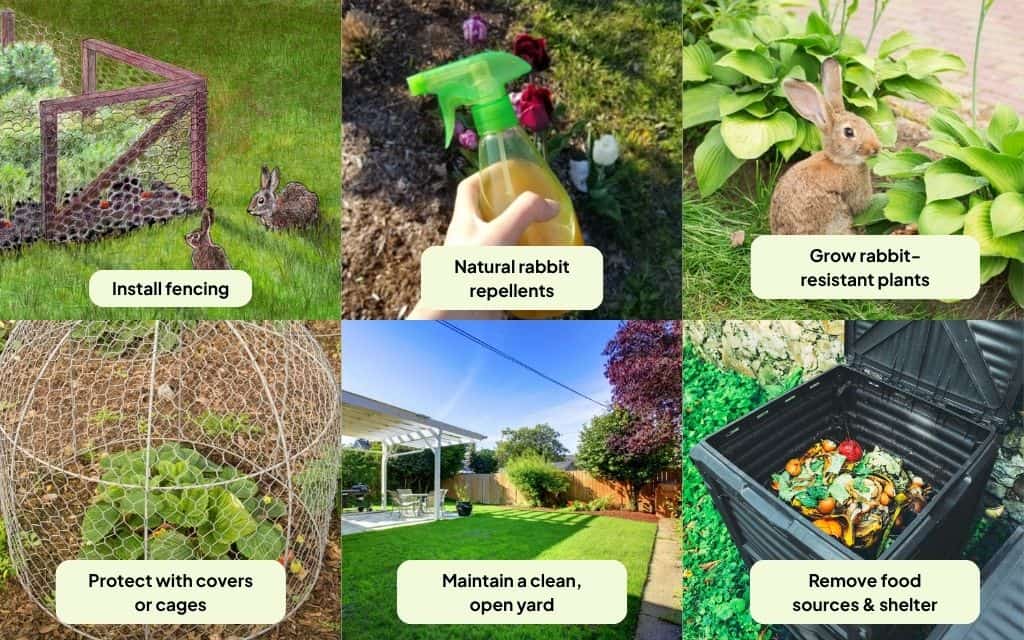
7. Use motion-activated sprinklers or lights
Technology offers hands-off solutions for those seeking how to keep rabbits out of my garden without constant monitoring.
- Startle rabbits safely using motion-activated devices. When a rabbit triggers the sensor, sudden water spray or bright lights create a frightening experience without causing actual harm. This classical conditioning teaches rabbits your garden is an unpleasant place to visit.
- Best placed along garden perimeters or entry points, these devices guard the most vulnerable access routes.
Tip: Combine with fencing for maximum effect.
While motion-activated devices work well, clever rabbits eventually learn to approach from angles that avoid sensors. Using these tools as part of a multi-layered defense system prevents adaptation.
8. Apply scent deterrents regularly
Rabbits rely heavily on their sense of smell to evaluate safety and find food. Exploiting this dependence makes scent-based methods a powerful natural rabbit deterrent option.
- Blood meal (a nitrogen-rich fertilizer) carries a predator scent that triggers rabbits’ fear response.
- Dried sulfur smells like rotten eggs—unpleasant enough to repel most wildlife.
- Human hair from barbershops or hairbrushes signals human presence, making rabbits wary.
These odors confuse and repel rabbits by disrupting their ability to smell food or detect danger. The unfamiliar or threatening scents make your garden feel risky rather than rewarding.
9. Get help from natural predators
Nature provides its own rabbit population control through predator-prey relationships. Encouraging natural predators offers a sustainable, long-term approach to what repels rabbits.
- Encourage owls, hawks by keeping nesting areas nearby. These predators naturally limit rabbit populations without any effort on your part.
- Place a fake owl decoy or reflective tape to mimic predator presence.
- While rabbits eventually recognize stationary decoys, regularly moving them around maintains effectiveness. Reflective streamers, old CDs, or holographic tape create flashing movements that suggest predator activity.
- If you have a dog, regular yard time also deters rabbits. The scent of canine urine and the presence of a natural predator makes rabbits extremely nervous. Even small dogs effectively patrol yards and disrupt rabbit routines through their simple presence.
10. Rotate crops & plant layouts each year
Rabbits are surprisingly intelligent creatures with good memories. They remember where reliable food appeared last season and return to the same spots expecting repeat harvests.
Rotating your vegetables and altering bed layouts helps break these behavioral patterns.
Move your lettuce patch to a different area, relocate your bean rows, and shuffle your garden design annually. This forces rabbits to search your entire property rather than heading straight to known food locations.
This strategy works well when combined with other methods. Rabbits arriving at last year’s lettuce location now encounter marigolds or fencing instead – double the deterrent effect.
11. Combine barriers with repellents
The single most important lesson in how to keep rabbits out of your garden is this: layering methods are most effective. No single solution works perfectly for every situation or every rabbit.
Consider a three-tier approach – fencing plus repellent spray plus rabbit-resistant border plants. If rabbits overcome one obstacle, they encounter two more. This redundancy is what transforms moderate success into complete protection.
Start with the methods that best fit your budget and property, then add layers as needed. Even adding just one additional strategy to your current approach typically produces noticeable improvement.
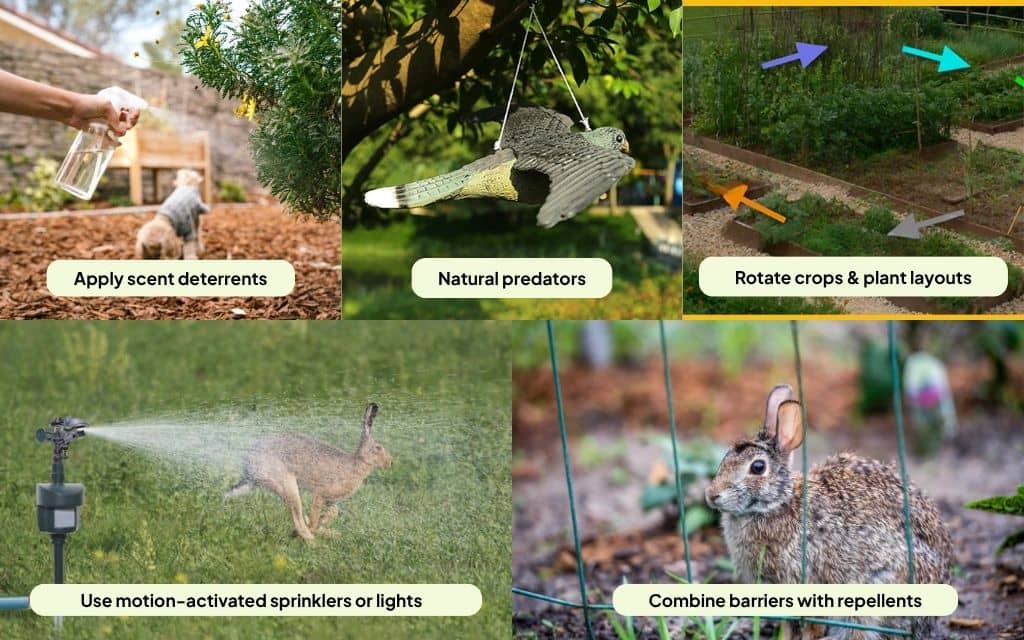
Eco-friendly and pet-safe rabbit control tips
- Avoid chemical repellents toxic to pets and pollinators: Many commercial rodent repellents contain harmful ingredients that can poison beneficial insects, birds, pets, and even children. Stick with natural options or products specifically labeled as safe for organic gardening.
- Compost naturally – don’t use bone meal or attractants in ways that might draw rabbits: While bone meal works as a repellent around plants, avoid adding it to open compost piles where its scent might initially attract curious rabbits investigating the smell.
- Create a balanced ecosystem that discourages pests naturally: Diverse plantings that support beneficial insects, birds, and predators create natural pest control. Native plants that attract dragonflies, ladybugs, and parasitic wasps help maintain garden health while supporting rabbit predators like hawks and owls.
Remember, the goal isn’t eliminating all wildlife from your property – it’s protecting your cultivated spaces while coexisting peacefully with nature.
Conclusion
Rabbits may be persistent garden visitors, but armed with the right strategies, you can successfully protect your garden without resorting to harmful methods.
The key to success lies in consistency – regularly reapplying deterrents, maintaining physical barriers, and staying vigilant about what attracts rabbits to your property in the first place.
Start by implementing the methods that best fit your budget, space, and gardening style. Even adopting just 2 or 3 of these proven strategies can dramatically reduce rabbit damage.
Remember that early intervention works best – addressing rabbit problems at the first sign of damage prevents establishing patterns that become harder to break.
Ready to transform your outdoor space into the garden of your dreams?
Explore our extensive collection of practical landscape guides to gain the knowledge and confidence you need for creating a thriving, beautiful yard that withstands whatever challenges nature presents.
Frequently asked questions (FAQs)
What smells do rabbits hate the most?
Strong scents like garlic, hot pepper, vinegar, and lavender effectively repel rabbits naturally. Other effective smells include predator urine, blood meal, and pungent herbs like rosemary and oregano. Rotate between different scents to prevent rabbits from adapting.
What plants do rabbits never eat?
Rabbits consistently avoid marigolds, lavender, salvia, and alliums due to their strong smell and texture. Other rabbit-resistant plants include geraniums, catmint, butterfly bush, vinca, and most herbs. Plants with fuzzy leaves, thorny stems, or toxic compounds also remain untouched.
How do I stop rabbits without harming them?
Use fencing, natural repellents, and scent barriers instead of traps or poisons. Physical barriers like buried chicken wire provide humane protection. Natural sprays made from hot peppers, garlic, or vinegar make plants unpleasant without causing harm. Motion-activated sprinklers safely startle rabbits away.
When are rabbits most active in gardens?
Early morning and evening during spring and summer. Rabbits are crepuscular (most active at dawn and dusk) when predators are less active. They’re particularly destructive in spring when hungry after winter and when gardens are full of tender new growth.
Will coffee grounds keep rabbits away?
Coffee grounds have a mild deterrent effect but work best when combined with stronger repellents or barriers. While some gardeners report success, the effect is inconsistent and temporary. Use coffee grounds as part of a multi-method approach rather than as your sole defense.
